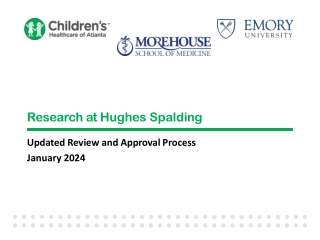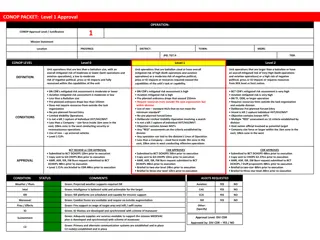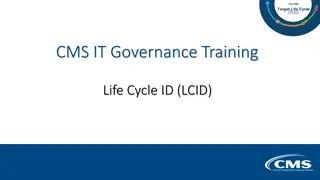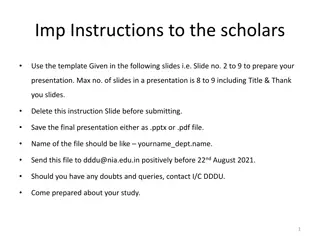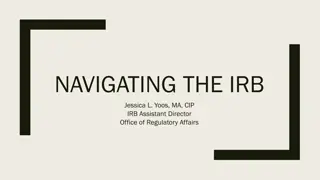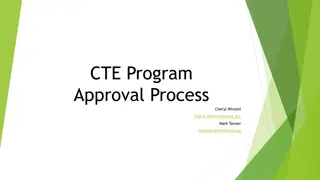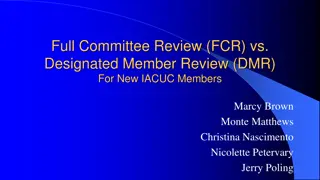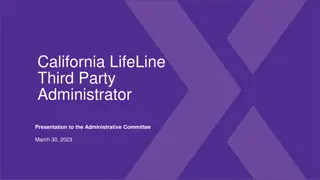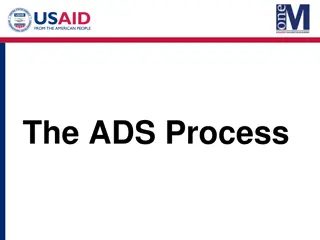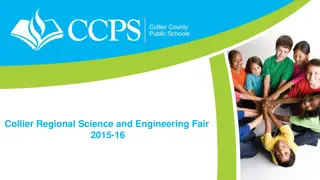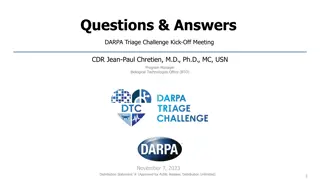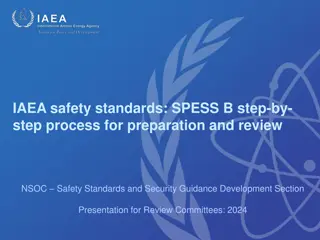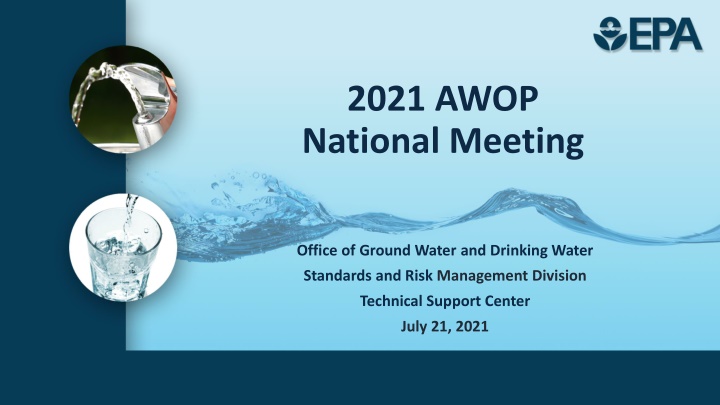
Drinking Water Methods and EPA ATP Program Overview
Discover the process of evaluating and approving drinking water methods, focusing on turbidity, along with insights into the EPA Drinking Water Alternate Test Procedure Program. Learn about expedited method approval processes and the importance of method validation for regulatory compliance in the water industry.
Download Presentation

Please find below an Image/Link to download the presentation.
The content on the website is provided AS IS for your information and personal use only. It may not be sold, licensed, or shared on other websites without obtaining consent from the author. If you encounter any issues during the download, it is possible that the publisher has removed the file from their server.
You are allowed to download the files provided on this website for personal or commercial use, subject to the condition that they are used lawfully. All files are the property of their respective owners.
The content on the website is provided AS IS for your information and personal use only. It may not be sold, licensed, or shared on other websites without obtaining consent from the author.
E N D
Presentation Transcript
2021 AWOP National Meeting Office of Ground Water and Drinking Water Standards and Risk Management Division Technical Support Center July 21, 2021
Disclaimer The information in this presentation has been reviewed and approved for public dissemination in accordance with U.S. Environmental Protection Agency (EPA). The views expressed in this presentation are those of the author(s) and do not necessarily represent the views or policies of the Agency. Any mention of trade names or commercial products does not constitute EPA endorsement or recommendation for use. 2
Drinking Water Methods: Evaluation and Approval Method Focus: Turbidity 3
Drinking Water Methods Methods are approved through a Regulation (Rule) or the Expedited Method Approval Process Many methods developed at EPA or other government agencies Some developed by vendors e.g., Hach, Palintest, Tintometer, Swan Standards organizations - ASTM, Standard Methods EPA Drinking Water Alternate Test Procedure (ATP) Program Evaluates new or modified test methods to determine if method is equally effective in performance relative to methods already approved in regulations 4
EPA Drinking Water ATP Program https://www.epa.gov/dwanalyticalmethods/drinking-water-alternate-test-procedure-program ATP program evaluates modified or new testing methods Accepted submissions are methods, not technologies or instrumentation Methods must undergo sufficient validation to support their use at the national level (multi-lab validation/multi-DW matrices) Must demonstrate method robustness through method performance data and meeting QC acceptance criteria Single laboratory or Regional approvals apply to wastewater methods, not drinking water methods ATP program does not have authority to approve alternate testing procedures 5
Expedited Method Approval Process http://www.epa.gov/dwanalyticalmethods/expedited-drinking-water- analytical-method-approval-requirements Alternate methods approved through a Federal Register Notice Once published in the FR, methods are fully U.S. EPA approved for regulatory compliance monitoring Time required for approval significantly shortened Notice-and-comment rulemaking: 2-3 years following method evaluation Expedited process: < 1 year Expedited methods are in Appendix A to Subpart C of 40 CFR Part 141 State adoption of alternative test methods is optional; however, if these methods are used, laboratory certification requirements extend to the use of methods approved through the expedited process 6
Expedited Method Approval Process http://www.epa.gov/dwanalyticalmethods/expedited-drinking-water-analytical- method-approval-requirements Frequency of approvals Publishing FR notices on approximately an annual basis Expedited Method Approvals could include Methods evaluated through the EPA Drinking Water ATP program; Standard Methods and ASTM methods; and New or revised EPA methods Example EPA Method 127 (Monochloramine) was developed by EPA, compared with approved Standard Method 4500-Cl G, validated in-house and by two additional water systems, then included in the most recent Expedited Method Approval action 7
Where can I find Approved Methods? Approved methods are listed on OGWDW s web site http://www.epa.gov/dwanalyticalmethods/approved-drinking-water- analytical-methods Tables of approved methods Grouped by regulation/monitoring requirement, sorted by contaminant 8
Method Focus: Turbidity Turbidity is a method-defined parameter Not a specific chemical that is measured, but a physical parameter EPA Method 180.1 established design specifications, quality control and calibration requirements for turbidity measurement by nephelometry Primary standard (formazin) used for calibration Secondary standard used for routine daily calibration checks Light sources EPA Method 180.1 set specifications for tungsten lamps Newer methods use LED or laser-based light sources 9
Method Focus: Turbidity Turbidity methods approved since 2009 Laser-based nephelometry Mitchell M5271, Hach Method 10258 (360o Nephelometry), Tintometer Lovibond 6000 LED-based nephelometry Mitchell M5331, Swan AMI Turbiwell, Thermo AQ4500, Tintometer Lovibond 1000, Tintometer Lovibond 2000 Revised Hach 8195, Rev. 3.0 (tungsten/LED) & 10258 (Laser 360o) Previously sealed standards could only be used as secondary calibration verification checks. Quarterly preparation of liquid standards were required Hach conducted long-term stability studies using sealed StablCal for calibration The two revised methods were approved in October 2018, allowing the use of prefilled sealed StablCal vials as primary calibration standards specifically for these two Hach methods 10
Turbidity Method Progress Recent high influx of turbidity method ATP submissions and inquiries EPA met with Swan representatives to discuss pending revisions to their approved Turbiwell method related to method calibration procedures and implementation of a Primary Standard Kit ATP evaluation of portable turbidity methods that can be used for drinking water compliance monitoring Evaluation of additional primary standards, such as other sources of sealed stabilized Formazin 11
Common Turbidity Concerns and Questions What impact do light sources (tungsten bulbs, LEDs, lasers) have on the instrumentation in approved methods? Light sources can have different properties, such as spectral wavelengths, that detect different sizes of particles. Because the results produced by these light sources can differ, the light sources are not interchangeable between instruments. However, several approved methods exist that use many types of light sources. These approved methods have been validated and shown to produce results that meet drinking water regulatory requirements. 12
Common Turbidity Concerns and Questions Are low turbidity results accurate knowing that low turbidity standards are not available or cannot be easily prepared or maintained? The linearity of turbidity calibration curves has been well established. It is accepted in the scientific community that turbidity results are accurate to low levels even when extrapolating down beyond available calibration standards. Refer to the method when determining the turbidity limits for an approved method. 13
Common Turbidity Concerns and Questions What is the importance of calibration quality control, such as calibration verification? One of the first steps of any quantitative method is the determination of a calibration curve. Once the calibration curve has been established, it is important to ensure that the calibration curve continues to be valid over the course of use and reporting. Calibration verification at some frequency ensures that the calibration curve is still in control and meeting method acceptance criteria. Verification failures can result from minor instrument drift to complete instrument failure, such as light source or detector malfunction. Proper calibration and calibration verification is described in approved turbidity methods. Any changes to calibration or verification procedures is considered a significant change to the approved method and must be evaluated by EPA. 14
Common Turbidity Concerns and Questions What are acceptable primary and secondary calibration standards? Primary calibration standards consist of prepared or purchased formazin or styrene divinylbenzene (SDVB) polymer suspensions. Sealed, stabilized formazin standards may only be used if they have been evaluated and deemed acceptable by EPA. Primary calibration standards are used for instrument calibration. Secondary calibration standards consist of sealed, stabilized formazin or SDVB standards that have not been evaluated by EPA, gel or solid standards, or any other mechanism or device calibrated against properly prepared primary calibration standards. Secondary standards may be used for calibration verification but must be checked for deterioration and replaced as required. 15

